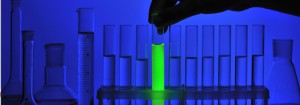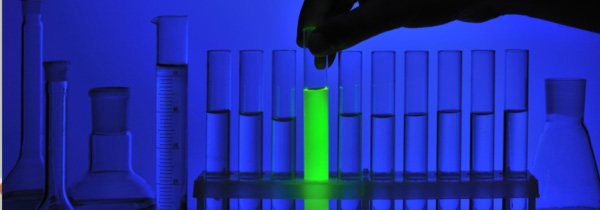Killing Tumors with Light: Insights into Anti-Tumor Immunity
The ideal form of cancer therapy should be able to selectively destroy the cells making up the tumor while at the same time activating the immune system so that it can recognize and ultimately eliminate any metastatic cancer cells—those that are found away from the primary tumor.
Such a treatment for cancer already exists in the form of photodynamic therapy, or PDT, and it is steadily gaining traction among today’s oncologists. Among the reasons for PDT’s growing popularity is its ability to work with the body’s own highly sophisticated protective system, the immune system. Whereas chemotherapy, radiotherapy and surgery all tend to suppress the immune system, PDT has the opposite effect. This light-based approach bolsters the anti-cancer immune defenses in just the right way, hitting the disease both locally (attacking the tumor) and systemically (via anti-cancer immunity, which protects the whole body).
So how does this occur? PDT entails the use of a photosensitizing agent that has the unique ability to capture and transmit the energy of light. This agent can preferentially accumulate in cancer cells over time. Upon exposure to light of a particular wavelength, and in the presence of oxygen, a photochemical reaction takes place that results in the generation of reactive oxygen molecules. These highly reactive molecules are able to break down and ultimately destroy the tumor.
Aside from its direct tumor-killing effects, PDT also has several indirect effects that provide a strong therapeutic advantage. One of these effects is its ability damage the tumor’s blood supply. Another indirect effect is to induce the release of pro-inflammatory molecules that help ignite the immune system.
This brings us back to the heart of this article’s topic: With PDT, the immune system is activated in very specific ways so that it can recognize the presence of cancers and infections. Again, the goal is to destroy the tumor while simultaneously clearing away any other cancer cells that may be elsewhere in the body—thus helping to stave off the return of more aggressive cancer later on.
Indeed, recent laboratory studies of breast and colon cancer have confirmed this dual action of PDT. The research indicates that PDT’s impact on the immune system results in greater control of both the primary tumor and metastases, as reported online ahead-of-print in the 11 November 2014 issue of Cancer Immunology, Immunotherapy. Given that metastases are the may cause of most cancer-related deaths, it stands to reason that far more research attention should be devoted to PDT’s profound therapeutic potential.
PDT’s Impact on Anti-Cancer Immunity: Recent Insights
How exactly does PDT reprogram the immune system to become highly active against cancer? The basic approach involves focusing an infrared laser on the tumor itself, an approach known as laserthermia. The tumor’s internal temperature rises dramatically, to the point that tumor cells begin to die off. As the tumor cells swell up and die, they release key proteins, the so-called tumor antigens, which in turn can stimulate the body’s anti-cancer immunity.
Pivotal to the effectiveness of the anticancer immune defenses is a group of star-shaped cells known as the dendritic cells. These function as “sentinels” for the immune system because they are constantly on the lookout for potential signs of disease. With the help of other immune cells, dendritic cells are able to capture the tumor antigens and then migrate to lymph nodes, where they interact with T-cells to trigger an aggressive immune response against the cancer.
Unfortunately, dendritic cells tend to be inactive or “asleep” when cancer is present. That is, these cells tolerate the existence of the tumor, as if it were simply part of the body.
PDT is a way of “waking up” the dendritic cells so that they become fully functional and active against the disease. Photodynamic treatment can accomplish this because it changes the surface of the tumors, revealing specific structures called Damage-Associated Molecular Patterns, or DAMPs. These DAMPs may play a critical role in the therapeutic success of PDT and various immunotherapy strategies.
When the dendritic cells are exposed to both the DAMPs and the tumor antigens at the same time, the rest of the anti-cancer immune response springs into action, and the remaining cancer can be effectively eliminated, as discussed in a report in BioMed Research International titled “Immunogenic cell death: can it be exploited in PhotoDynamic Therapy for cancer?”.
One type of cell death triggered by PDT is known as necrosis. This form of cell death is considered ideal for keeping the immune system actively engaged against the cancer. This appears to be one of the key pieces to the puzzle of anti-tumor immunity. In contrast, high-dose chemotherapy kills tumors in ways that dampen the immune system’s ability to target cancer cells.
Immuno-PDT: Super-Charging the Immune Response
Dr. Michael Hamblin is based at the Wellman Center for Photomedicine in Boston, Massachusetts (USA), which is part of the prestigious Harvard Medical School. In laboratory experiments at the Center, it was shown that the acute inflammatory response following PDT results in the highly active “clean-up” process on the part of the immune system. Specialized cells are able to infiltrate the tumor and remove the damaged cells—all part of the adaptive anti-tumor immune response.
The Harvard research team reports that the powerful acute inflammatory response prompted by PDT causes neutrophils and other immune cells to accumulate in large numbers at the light-treated site—the tumor or cancerous area. This ultimately results in the tumor’s complete eradication, as reported in the 27 March 2014 issue of the World Journal of Immunology.
Dr. Hamblin’s research also clearly shows that a single PDT treatment can not only destroy the primary tumor, but also induces a whole-body immune response capable of destroying distant metastases. As you might guess, these findings have profound implications for the future of cancer medicine.
If the immune system is already severely compromised, as in the case of many advanced-stage cancers, then additional support is often needed. In these cases, adding interferon and other immune-modulating substances (generally called immune adjuvants) can further enhance the therapeutic outcome.
This Immuno-PDT strategy has already been explored for the treatment of warts, actinic keratosis and basal cell carcinoma, the most common form of skin cancer. Recent studies suggest that it shows excellent potential for the treatment of advanced cutaneous melanoma, even when used on a stand-alone basis—that is, without the addition of conventional treatment. Malignant melanoma is a highly immunogenic cancer, meaning that it can elicit a strong immune response; this makes it an excellent candidate for exploring Immuno-PDT strategies.
Dr. Mladlen Korbelik at the British Columbia Cancer Agency (Canada) has demonstrated that PDT can result in the rapid destruction of tumors. As the tumor cells are dying, the signals they release provoke the body to launch protective actions for dealing with a threat to tissue integrity. Again, this was shown to produce a strong acute inflammatory reaction, which in turn brought about a potent whole-body immune response against the tumor.
Finally, studies conducted at the Roswell Park Cancer Institute in Buffalo, New York (USA), support the use of an immune-enhancing PDT regimen as an adjuvant treatment—that is, in tandem with surgery and possibly other conventional treatments. The Roswell group found that when PDT is used in conjunction with therapies that inhibit or do not enhance immunity, it has the potential to enhance anti-tumor immunity and reduce metastatic growth.
Other recent studies have confirmed that PDT is an effective complement to surgery and that boosts the likelihood of long-term cancer control following the operation. Much of this research was reviewed in a 2011 issue of CA: A Cancer Journal for Clinicians, and more recently in the 11 November 2014 online issue of Cancer Immunology, Immunotherapy.
In summary, Immuno-PDT strategies may lead to therapeutic outcomes that far surpass what can be achieved with other forms of cancer treatment and immunotherapy. The biological rationale behind Immuno-PDT has already begun to illuminate a whole new way of thinking about optimal cancer treatment, one that attacks the disease from multiple angles simultaneously and that encompasses the whole body.
Support us by buying our book, The Medicine of Light, and ebooks from our Photoimmune Discoveries eBook Series.
Sources
Reginato E, Wolf P, Hamblin MR. Immune response after photodynamic therapy increases anti-cancer and anti-bacterial effects. World J Immunol. 2014 Mar 27;4(1):1-11.
Shams M, Owczarczak B, Manderscheid-Kern P, Bellnier DA, Gollnick SO. Development of photodynamic therapy regimens that control primary tumor growth and inhibit secondary disease. Cancer Immunol Immunother. 2014 Nov 11. [Epub ahead of print]
Hayashi N, Kataoka H2, Yano S, Tanaka M, Moriwaki K, Akashi H, Suzuki S, Mori Y, Kubota E, Tanida S, Takahashi S, Joh T. A novel photodynamic therapy targeting cancer cells and tumor-associated macrophages. Mol Cancer Ther. 2014 Dec 15. [Epub ahead of print]
Wachowska M1, Gabrysiak M1, Golab J2. Epigenetic remodeling combined with photodynamic therapy elicits anticancer immune responses. Oncoimmunology. 2014 May 15;3:e28837. eCollection 2014.
Garg AD, Agostinis P. ER stress, autophagy and immunogenic cell death in photodynamic therapy-induced anti-cancer immune responses. Photochem Photobiol Sci. 2014 Mar;13(3):474-87.
Agostinis P, Berg K, Cengel KA, Foster TH, Girotti AW, Gollnick SO, Hahn SM, Hamblin MR, Juzeniene A, Kessel D, Korbelik M, Moan J, Mroz P, Nowis D, Piette J, Wilson BC, Golab J. Photodynamic therapy of cancer: an update. CA Cancer J Clin. 2011; 61:250–281
Skupin-Mrugalska P, Sobotta L, Kucinska M, Murias M, Mielcarek J, Düzgüneş N. Cellular changes, molecular pathways and the immune system following photodynamic treatment. Curr Med Chem. 2014;21(35):4059-73.
© Copyright 2015, Photoimmune Discoveries, BV





 English
English Français
Français Deutsch
Deutsch Nederlands
Nederlands